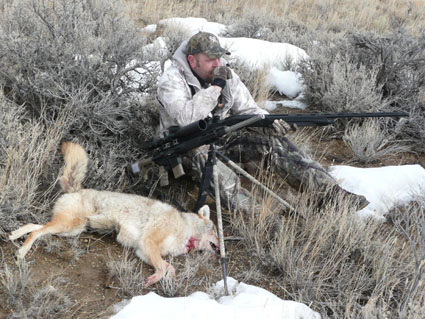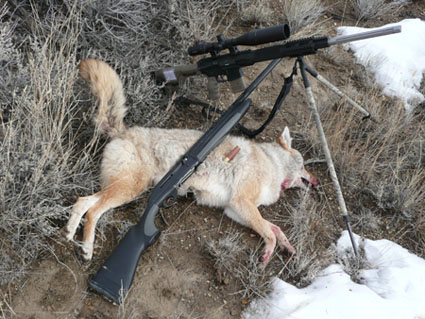 The author calling with his shotgun in hand, ready for a charging coyote. |
It was breaking daylight as I quietly approached my first stand. I was positioned on a small hill overlooking a wide expanse of CRP grass. Just a few yards in front of me crow decoys were perched above the electronic caller. I opened with a single female interrogation howl to which several coyotes responded. After a couple of minutes, I switched to bird sounds mixed with jackrabbit distress. About five minutes into the stand four coyotes charged toward me. They were racing each other for a free meal. At about 200 yards they were distracted by a live rabbit. As they veered off-course I gave a few squeaks on my coaxer. Fortunately they turned and headed right into my lap.
I slowly raised my semi-auto 12 gauge and took aim. At less than 10 yards I fired and the first coyote went down. I quickly swung to the right and rolled the second coyote inside 20 yards. Two shots later the third coyote was dead. I grabbed the rifle, but was not able to connect on the fourth coyote before he was over the hill. The sun hadn’t even peeked over the horizon and I had three coyotes on the ground.
Carry a Shotgun AND Rifle
Every year I kill several coyotes with a shotgun that would be difficult or impossible with a rifle. It’s amazing how they suddenly appear, even in open country. I like to hold my shotgun and have my rifle on sticks or a bi-pod next to me. If one or more coyotes come into shotgun range I am ready. If they hang up I slowly put down the shotgun and switch to the rifle. It’s important to practice this and get comfortable with both guns on stand.
When I’m calling coyotes I want them close enough to smell their breath. The closer they are when the shooting begins, the more likely I’ll be to kill two or three. A shotgun is an important part of this equation. When they’re really close it’s difficult to find them in the scope, especially if they’re moving. With a shotgun I can quickly kill the close ones and switch to the rifle for the others.
Call New Areas
 Montana coyote taken at close range with Hevi-Shot Dead Coyote ammunition. |
A shotgun gives you the ability to call areas you wouldn’t consider otherwise. These areas include thick brush, river bottoms, and dense cedar pockets to name a few. I’ve learned these areas are often overlooked by other predator callers. They tend to leave them alone because they’re difficult to hunt with a rifle. Adding a shotgun to your bag of tricks opens up a whole new world of stands you can select. I have had some amazing days sitting back-to-back with my partner in cedar pockets or thick sage flats. It’s important to have the shotgun ready as they’ll be on you before you know it.
Watch Your Wind
When calling with a shotgun the wind is very important. More often than not coyotes circle to the down-wind side of their prey. They use their nose to help determine if the sound is authentic. I try to avoid stands with tight cover on windy days. They typically smell you before you see them.
Use The Right Equipment
Over the years I have killed several coyotes at or beyond the 70-yard mark with a shotgun. With a little practice and the right equipment 50 yards is a chip-shot. I strongly recommend an after-market choke tube such as the Dead Coyote Choke from Hevi-Shot. I shoot 3-inch Dead Coyote Ammunition loaded with size T pellets. #4 Buck is also very popular. It’s important to pattern your shotgun at different ranges so you know what to expect in the field.
Is It Absolutely Necessary?
When I started calling coyotes almost 20 years ago I had a rifle and a mouth call. Over the years I’ve acquired more equipment and learned techniques that have improved my success. A shotgun is one of these items. Carrying a shotgun means more to carry into your stand, and frequently more coyotes to drag back to the truck. Are you up to dragging more coyotes?
About The Author
Dustin has been calling predators for nearly 20 years. He has competed in coyote calling contests around the Western U.S. for more than a dozen years and has consistently excelled including many wins and top finishes. He enjoys sharing his knowledge of predator hunting with others through calling seminars and magazine articles. To learn more about Dustin or the equipment he uses visit www.predatordown.com.






